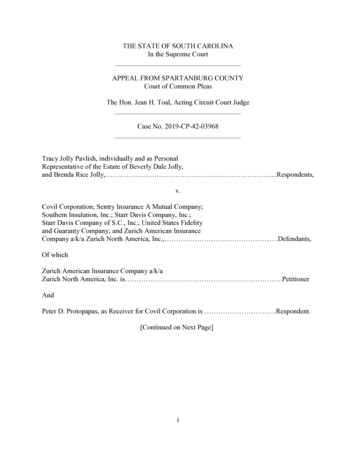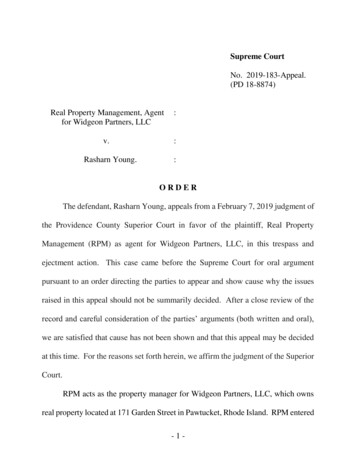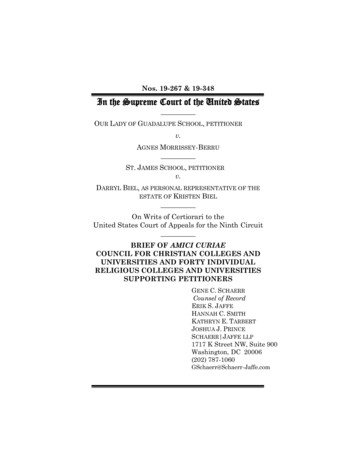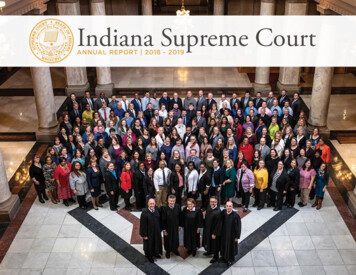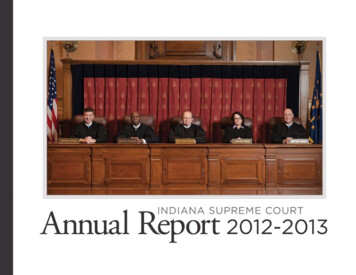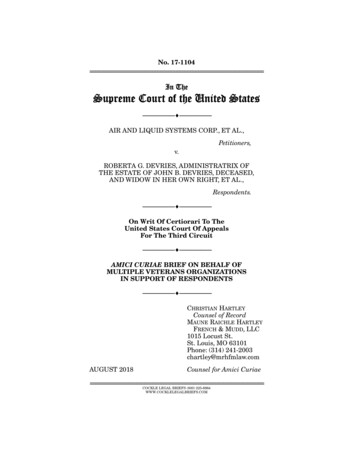
Transcription
No. 17-1104 In TheSupreme Court of the United States--------------------------------- --------------------------------AIR AND LIQUID SYSTEMS CORP., ET AL.,Petitioners,v.ROBERTA G. DEVRIES, ADMINISTRATRIX OFTHE ESTATE OF JOHN B. DEVRIES, DECEASED,AND WIDOW IN HER OWN RIGHT, ET AL.,Respondents.--------------------------------- --------------------------------On Writ Of Certiorari To TheUnited States Court Of AppealsFor The Third Circuit--------------------------------- --------------------------------AMICI CURIAE BRIEF ON BEHALF OFMULTIPLE VETERANS ORGANIZATIONSIN SUPPORT OF RESPONDENTS--------------------------------- --------------------------------CHRISTIAN HARTLEYCounsel of RecordMAUNE RAICHLE HARTLEYFRENCH & MUDD, LLC1015 Locust St.St. Louis, MO 63101Phone: (314) 241-2003chartley@mrhfmlaw.comAUGUST 2018Counsel for Amici Curiae COCKLE LEGAL BRIEFS (800) 225-6964WWW.COCKLELEGALBRIEFS.COM
iTABLE OF CONTENTSPageINTEREST OF AMICI CURIAE .1SUMMARY OF ARGUMENT .2ARGUMENT .5I.II.MARITIME LAW HAS HISTORICALLYPROVIDED SAILORS WITH SPECIALSOLICITUDE WHICH DEMANDS THERECOGNITION OF A DUTY ON PETITIONERS IN THIS CASE .5PETITIONERS HAD A DUTY TO WARNOF THE FORESEEABLE USE OF THEIRASBESTOS-CONTAINING PRODUCTSWHEN THEY KNEW SUCH USE WOULDEXPOSE U.S. NAVY SAILORS TO ASBESTOS . 13A. It was the use of Petitioners’ fully functional products – including the integralasbestos wear parts – that caused Respondents harm and triggered a duty towarn . 16B. Petitioners had a duty to warn becausethey were in the best position to preventthe harm and could have easily warnedU.S. Navy sailors of the danger . 20C. Upholding the Third Circuit’s narrowfinding of duty on the part of equipmentmanufacturers will not lead to Petitioners’ dystopian future of rampant liability and superfluous warnings . 23
iiTABLE OF CONTENTS – ContinuedPageIII.MARITIME LAW COMPELS THE ADOPTION OF THE NATIONAL TREND RECOGNIZING A DUTY TO WARN AGAINSTFORESEEABLE ASBESTOS EXPOSUREINCUMBENT IN THE ROUTINE ANDNECESSARY REPAIR OF MANUFACTURERS’ PRODUCTS . 26IV.ALLOWING PETITIONERS TO ESCAPELIABILITY FOR THEIR ASBESTOSCONTAINING PRODUCTS WOULDPRECLUDE U.S. SAILORS FROM OBTAINING COMPLETE REDRESS FOR THEIRWRONGFULLY-CAUSED INJURIES . 30A. Precluding claims against Petitionerswould eviscerate the tort remedy veterans have had against negligent equipment manufacturers for decades . 31B. Neither the asbestos bankruptcy trustsystem nor the VA benefits systemprovides adequate compensation forthe preventable suffering and death ofthose veterans exposed to Petitioners’asbestos . 33C. Neither the VA nor the bankruptcytrust system fulfills the foundationalproduct liability tenet of deterrencethat can only be provided by the civiljustice system . 37CONCLUSION. 38
iiiTABLE OF CONTENTS – ContinuedPageAPPENDIXLetter to Mr. G. Hiner from William J. Taylor,M.D., General Electric (January 23, 1979). App. 1Excerpts from Responses of Defendant BuffaloPumps, Inc. to Plaintiffs’ Standard Interrogatories, Superior Court of the State of California, in and for the County of Los Angeles(December 27, 2006). App. 4Amendment or Solicitation/Modification of Contract Between NAVAL Regional ProcurementOffice and Foster Wheeler Corp. App. 11Excerpts from Technical Manual on the Description, Operation and Maintenance Instructionsfor the 1200 PSI Main Boiler, Foster WheelerCorp. (May 15, 1980) . App. 21
ivTABLE OF AUTHORITIESPageCASESAppalachian Ins. Co. v. General Elec. Co., 863N.E.2d 994 (N.Y. 2007) .31Atlantic Sounding Co., Inc. v. Townsend, 557U.S. 404 (2009) . 37, 38Borel v. Fibreboard Paper Prods. Corp., 493 F.2d1076 (5th Cir. 1973) .10Boyle v. United Technologies Corp., 487 U.S. 500(1988) .11Braaten v. Saberhagen Holdings, 198 P.3d 493(Wash. 2008) . 28, 29Chandris, Inc. v. Latsis, 515 U.S. 347 (1995).7Chesher v. 3M Co., 234 F.Supp.3d 693 (D.S.C.2017) . 26, 29Chicano v. General Elec., Co., 2004 WL 2250990(E.D. Pa. 2004) .17Daigle v. Point Landing, Inc., 616 F.2d 825 (5thCir. 1980) . 7, 14East River Steamship Corp., 476 U.S. 858(1986) . passimExxon Shipping Co. v. Baker, 554 U.S. 471(2008) .37Harden v. Grodon, 11 F.Cas. 480 (D. Me. 1823) .6Holdren v. Buffalo Pumps, Inc., 614 F.Supp.2d129 (D. Mass 2009) .12
vTABLE OF AUTHORITIES – ContinuedPageIn re Hawaii Fed. Asbestos Cases, 665 F.Supp.1454 (D. Haw. 1986) .31In re New York City Asbestos Litig. (Dummitt),59 N.E.3d 458 (N.Y. 2016) . 9, 21, 26, 27Kaiser v. Armstrong World Ind., Inc., 678 F.Supp.29 (D.P.R. 1987) .31Kosmynka v. Polaris Ind., Inc., 462 F.3d 74 (2dCir. 2006) .19Macias v. Saberhagen Holdings, Inc., 282 P.3d1069 (Wash. 2012) .29Mack v. General Elec. Co., 896 F.Supp.2d 333(E.D. Pa. 2012) .14MacPherson v. Buick Motor Co., 111 N.E. 1050(N.Y. 1916) .13Mavroudis v. Pittsburgh-Corning Corp., 935P.2d 684 (Wash. Ct. App. 1997) .33May v. Air & Liquid Systems Corp., 129 A.3d 984(Md. 2015) . 21, 27, 28McKenzie v. A.W. Chesterton Co., 373 P.3d 150(Or. Ct. App. 2016) .29Miles v. Apex Marine Corp., 498 U.S. 19 (1990) .29Miranda v. Abex Corp., 2008 WL 4778886(S.D.N.Y. 2008) .12Moragne v. States Marine Lines, Inc., 398 U.S.375 (1970) . 6, 7Norfolk Shipbuilding & Drydock Corp. v. Garris,532 U.S. 811 (2001) .7O’Neil v. Crane Co., 266 P.3d 987 (Cal. 2012) .29
viTABLE OF AUTHORITIES – ContinuedPagePiccirelli v. Johns-Manville Sales Corp., 128A.D.2d 762 (N.Y. App. Div. 1987) .31Poage v. Crane Co., 523 S.W.3d 496 (Mo. Ct. App.2017) . 21, 25, 29Pope & Talbot v. Hawn, 346 U.S. 406 (1953) . 7, 11Quirin v. Lorrillard Tobacco Co., 17 F.Supp.3d760 (N.D. Ill. 2014) . 14, 15, 17, 22Saratoga Fishing Co. v. J.M. Martinac & Co., 520U.S. 875 (1997) . 14, 18Simonetta v. Viad Corp., 197 P.3d 127 (Wash.2008) .29Summers v. Tice, 199 P.2d 1 (Cal. 1948) .15Swogger v. Waterman S.S. Corp., 518 N.Y.S.2d715 (N.Y. App. Div. 1987) .6The Lottawana, 88 U.S. 558 (1874) . 6, 26Whelan v. Armstrong Int’l, Inc., 2018 WL3716036 (N.J. Sup. Ct. 2018) . 14, 26Wible v. Keene Corp., 1987 WL 15833 (E.D. Pa.1987) .31Willis v. Buffalo Pumps, Inc., 34 F.Supp.3d 1117(S.D. Cal. 2014) .29Wolfe v. Ford Motor Co., 376 N.E.2d 143 (D.Mass. 1978) .25
viiTABLE OF AUTHORITIES – ContinuedPageWoo v. General Elec. Co., 393 P.3d 869 (Wash. Ct.App. 2017) . 9, 15, 29Woodling v. Garret Corp., 813 F.2d 543 (2d Cir.1987) .16OTHER AUTHORITIESRules for the Regulation of the Navy of theUnited Colonies of North-America, Nov. 28,1775 .638 U.S.C. § 1311(a)(1) .36Restatement (Second) of Torts § 402A(1965) . 14, 15, 17Alani Golanski, When Sellers of “Safe” ProductsTurn Ostrich in Relation to Dangerous PostSale Components, 39 Sw. L. Rev. 69 (2009) .19J.R. Millette, et al., Asbestos-Containing SheetGaskets and Packing, in Sourcebook on Asbestos Diseases, Vol. 12. Asbestos Health Risks153-188 (1996) .19Owens Corning/Fibreboard Asbestos PersonalInjury Trust Distribution Procedures (Dec. 2,2015) .34Notice of Current Payment Percentage, OwensCorning/Fibreboard Asbestos Personal InjuryTrust (Aug. 8, 2017) .34Manville Personal Injury Settlement Trust Distribution Process (Jan. 2012) .35
viiiTABLE OF AUTHORITIES – ContinuedPageManville Personal Injury Settlement Trust ProRata Announcement (Nov. 8, 2016) .35Hon. Mark Davidson, et al., Asbestos Bankruptcy Trusts and Their Impact on the TortSystem, 7 J.L. Econ. & Pol’y 281 (2010) .36
1INTEREST OF AMICI CURIAE1Amici are organizations that advocate for therights and interests of those who served in the UnitedStates Navy. These organizations are comprised of U.S.Navy veterans who served aboard submarines, destroyers, aircraft carriers and ships to protect American interests at home and abroad. Many of Amici’smembers were exposed to asbestos-containing equipment during their service. As a result, Amici have asignificant interest in ensuring maritime law providesaccess to justice for those veterans who were injuredby asbestos-containing products and equipment.The Retired Enlisted Association (“TREA”) is a501(c)(19) national organization comprised of retiredenlisted military men and women from all branches ofthe U.S. military. TREA has thirty-six active chaptersin the United States and Puerto Rico. Military Veterans Advocacy is a non-profit 501(c)(3) organizationwith over 10,000 followers that works to protect therights and benefits of current and former military servicemen. The Blue Water Navy Vietnam VeteransAssociation is a non-profit 501(c)(3) organization comprised of 800 members and 3500 followers that supports veterans of all wars and advocates on behalf of1Pursuant to Supreme Court Rule 37, all parties receivedtimely notice of Amici’s intent to file and consented to the filing ofthis brief. Amici state that no party’s counsel authored the briefin whole or in part; no party’s counsel contributed money that wasintended to fund preparing or submitting the brief; and no person– other than Amici and their counsel – contributed money intended to fund preparing or submitting the brief.
2veterans injured during their service. The HamiltonCounty Veterans Association is a 501(c)(3) organization with hundreds of members that was created toprovide support and advocacy for military personneland their families.--------------------------------- ---------------------------------SUMMARY OF ARGUMENTFor as long as maritime law has existed in theUnited States, American sailors have relied on it forprotection from harm. The Third Circuit, acknowledging admiralty’s special solicitude for sailors, correctlyrecognized a duty on manufacturers whose products –used as intended – harmed American sailors. ThisCourt should reinforce maritime law’s protective underpinnings by upholding the opinion below.Under maritime law, Petitioners2 had a duty towarn of the foreseeable use of their asbestos-containing products since they knew such use would endangerthe lives of U.S. Navy sailors. Petitioners foresaw theasbestos hazard inherent in the routine repair andmaintenance of their products. Petitioners specified asbestos use, knew its application was certain, and ofteninstalled the initial asbestos components prior to delivery. At the time of Mr. DeVries’ service, many of Petitioners’ products required asbestos to function asdesigned in the specific high-temperature, high-pressuresystems at issue. It was this routine, intended and2References to “Petitioners” include General Electric Company who filed a separate brief on July 9, 2018.
3synergistic use of Petitioners’ products – including thenecessary asbestos wear parts Petitioners knew weredangerous – that triggered Petitioners’ duty to warn.A simple mask could have protected Respondentsfrom the harm caused by asbestos. Mr. DeVries testified he would have worn a mask if he had known usingPetitioners’ products would kill him. But he did notwear respiratory protection because Petitioners neverwarned him. The jurisdictional trend across the country holds manufacturers accountable for this negligentfailure to warn. In New York, Maryland and numerousother states, U.S. veterans would be entitled to compensation in this case. Refusing Respondents the sameredress here would undermine one of maritime law’scentral concerns: uniformity.Petitioners attempt to escape their unremarkableduty to warn their products’ users by cunningly redefining just what those products are. Instead of the fullyfunctional products they advertised and sold to theNavy, Petitioners seek to narrow this Court’s focus toskeletal “bare metal” components. But Petitioners’ myopic definition of a “product” conflicts with both traditional notions of product liability law and commonsense. Component parts like the foreseen or specifiedasbestos wear parts constitute part of the overall product, especially when they are necessary for the product’s intended use. Moreover, Petitioners were in thebest position to warn U.S. sailors of the foreseen hazards of their asbestos-containing products becausethey manufactured the static, longstanding equipmentthat synergistically worked with asbestos components
4to create those hazards. In fact, many equipment manufacturers (albeit after the timeframe at issue in thiscase) actually did warn sailors of the hazards of asbestos exposure attendant with the required repair – including Petitioners. See App. 4-10; 21-30. Despite all ofPetitioners’ post-hoc claims of impotence, they cannotdispute that they ultimately warned about the hazardsof asbestos lurking in their products – just not earlyenough to save Mr. DeVries and Mr. McAfee.Affirming the Third Circuit’s narrow finding ofduty on the part of equipment manufacturers will notlead to Petitioners’ dystopian future of rampant liability and superfluous warning. The rule adopted by thecourt below does not require manufacturers to warnabout products that could potentially be used in conjunction with their goods. Rather, the test requiresforeseeability of actual use of lethal substances, coupledwith some further action beyond mere knowledge ofsuch use. Petitioners’ parade of horribles does not withstand scrutiny under this common-sense analysis.Allowing Petitioners to escape liability for foreseeable harm caused by their product designs would preclude American veterans from obtaining completerelief and provide a concomitant windfall to manufacturers historically held to account by juries assessingthose manufacturers’ actions. Reversal would eviscerate the tort remedy historically available to these sailors. Despite Petitioners’ attempt to rewrite historyas it pertains to their culpability and their liability,Petitioners have been active defendants in asbestos
5litigation for decades, including in the very type of circumstances before this Court.Further, neither the asbestos bankruptcy trustsystem nor the U.S. veterans’ benefit system providesadequate compensation for the suffering and death ofsailors exposed to asbestos. Other commercial entitiesand the public fisc need not be required to subsidizetortfeasors’ negligent conduct. And neither system provides meaningful compensation to sailors sufferingfrom asbestos-caused lung cancer.Most importantly, U.S. veterans suffering the consequences of Petitioners’ conduct have an interest inutilizing American courts to prevent their brethrensailors from similar harm. Many seaman bring suit todisincentivize future misconduct despite knowing that– like Mr. DeVries and Mr. McAfee – they will likelynot live to see their recovery. This last act of serviceshould not be thwarted to assuage commercial interests.--------------------------------- E LAW HAS HISTORICALLYPROVIDED SAILORS WITH SPECIALSOLICITUDE WHICH DEMANDS THERECOGNITION OF A DUTY ON PETITIONERS IN THIS CASE.Maritime law’s special solicitude for sailors demands that Petitioners be held liable for their negligent failure to warn U.S. Navy sailors about the lethal
6hazards of asbestos exposure incident to the routine,intended use of their products. The Third Circuit’s ruling upholds the “humane and liberal character” of admiralty by providing Respondents with a remedy fortheir injuries. To allow Petitioners to escape liabilityfor the death of Mr. DeVries and Mr. McAfee would disregard centuries of maritime jurisprudence and undermine the protective policy heralded by this Court’sprior admiralty cases.The founders adopted the traditions and laws ofadmiralty as they existed at the time the Constitutionwas enacted. See The Lottawana, 88 U.S. 558, 565-66(1874). Even in 1775, in the so-called “Navy of theUnited Colonies of America,” sailors on American shipsrelied upon maritime law and traditions to providepredictability and protection. See Rules for the Regulation of the Navy of the United Colonies of NorthAmerica, Nov. 28, 1775, available at egulations-17751.html.The “overall purposes and designs of admiralty” serve“to protect those men and women who go to sea fromthe hazards of that endeavor, over which they have little or no control.” Swogger v. Waterman S.S. Corp., 518N.Y.S.2d 715, 720 (N.Y. App. Div. 1987).Justice Story proclaimed admiralty’s bedrockprinciple of sailor protection nearly two hundred yearsago in Harden v. Grodon, 11 F.Cas. 480, 485 (D. Me.1823). Since that time, maritime law has affordedthose who brave the treacherous seas “special solicitude” under U.S. law. Moragne v. States Marine Lines,
7Inc., 398 U.S. 375, 387 (1970). This Court has calculated that the “heightened legal protections” maritimelaw provides sailors is necessary to offset the specialhazards of the sea. Chandris, Inc. v. Latsis, 515 U.S.347, 354 (1995).Maritime law has protected sailors from injurycaused by the negligence of tortfeasors for well over acentury. Norfolk Shipbuilding & Drydock Corp. v. Garris, 532 U.S. 811, 820 (2001). In negligence cases specifically, the “traditional discretion” and f
J.R. Millette, et al., Asbestos-Containing Sheet Gaskets and Packing, in Sourcebook on Asbes-tos Diseases, Vol. 12. Asbestos Health Risks 153-188 (1996) . 19 Owens Corning/Fibreboard Asbestos Personal Injur

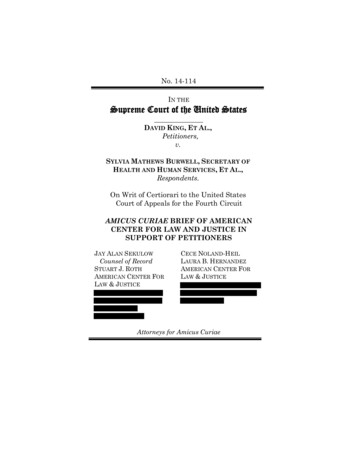
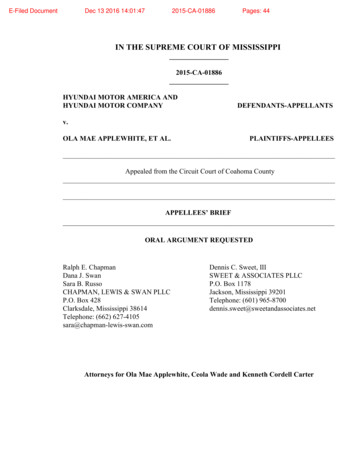
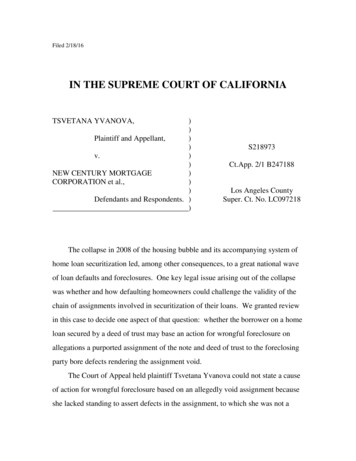
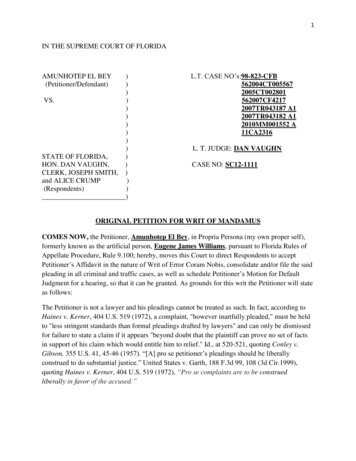
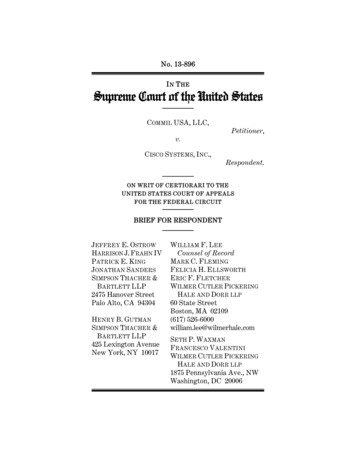
![IN THE SUPREME COURT OF T]-lE STATE OF MONTANA](/img/7/526b198c923f8.jpg)
